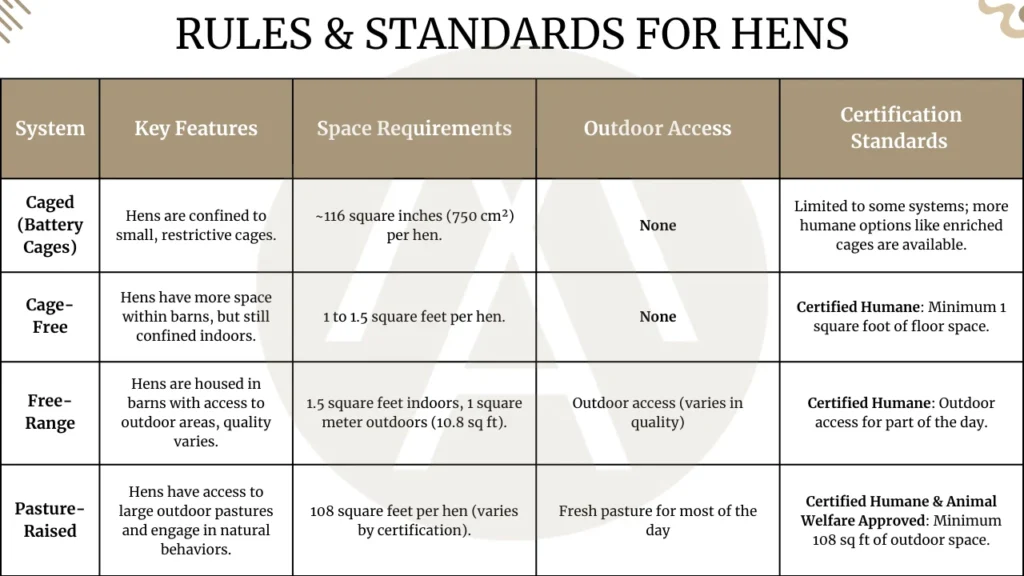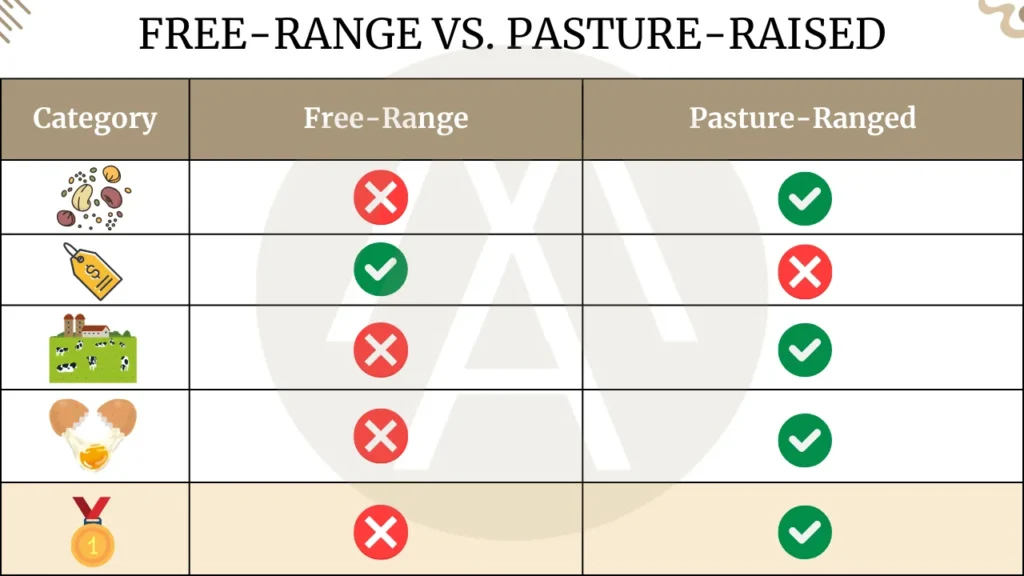Physical Address
304 North Cardinal St.
Dorchester Center, MA 02124
Physical Address
304 North Cardinal St.
Dorchester Center, MA 02124

Curious about which eggs are truly better? Pasture-raised eggs outshine free-range with richer nutrients like omega-3s and vitamin A, all thanks to hens' natural diets and spacious living conditions. Want to know why these eggs are a healthier choice for you and the planet?
When it comes to choosing the right eggs, we tend to buy the cheapest one out there. Eggs are just eggs, right?
Recent research tells us that this isn’t the case and that your choice of eggs has both a crucial environmental impact and an impact on your health. In today’s blog, I’ll uncover the two most famous choices nowadays: free-range vs pasture-raised, which is really better?
First, let’s go over all of the labels we found on eggs nowadays. These are in order, meaning caged chickens are close to animal abuse if you ask me.
Caged hens are put together in a 67-square-inch space each. Their diet consists of corn or soy diet, which you know, of course, is the worst nutrition for animals out there (check my latest blog if this is new to you)
Over 90% of eggs sold in the US come from hens that are kept within a small cage during their whole egg-giving career. No sunlight, no fresh air, just producing. Cruel.

Hens are given 1 square foot each for their entire life, which is not much. The term “Cage-Free” can be misleading since they remain in their barns and usually eat soy and corn.
Sounds great, right? What I think of when I think of free-range eggs, is that they are produced in big, sunny pastures, with all the freedom needed to produce the highest-quality eggs.
Quite the opposite is true.
While they have more space than caged and cage-free hens, they still don’t get as much sunlight as expected, with some rarely seeing blue sky. On average, hens receive about 2 square feet each.
Finally, some good stuff! These baddies are given at least 108 square feet each and have access to a wide range of grass, worms, bugs, or any other thing they find on the ground. These are access to farmers who really care about their farm, and not only go all in on profit.
They are released from their beds early in the morning and called back in before nightfall. In between these, pasture-raised hens are allowed to do whatever they want.

According to the Certified Humane & Animal Welfare Organizations, these are the requirements for hens.
One thing I noticed: “Outdoor access for part of the day.” What is that? Five minutes, five hours? We need stronger regulations for free-range animals to get closer to pasture-raised.
Let’s get into the differences between pasture-raised and free-range eggs. Firstly, I go deeper into the differences between the hens themself. After that, I’ll translate this exactly to the impact on your OWN health, so stay tuned.
Are you familiar with those way-to-small airplane seats that crack your posture in every single way? Those are even BIGGER than the average free-range chicken has to LIVE in.
The average airplane economy seat is 2.0 square feet, which is 0.5 bigger than the living space of a hen in the US.

Now, let’s have a look at the impact of free-range and pasture-raised eggs on your health. It is not rocket science to argue that pasture-raised is more nutrient-dense than free-range.
Just like with grass-fed beef or beef liver, what you put into the animal is what you put into yourself.
A 1999 study by Barb Gorski, a former farmer and researcher, tested meat from pasture-raised chicken in comparison to conventionally raised chicken in nutritional content.
A long one, but one with shocking results. Her conclusion: pastured poultry contains 21% less fat and 30% less saturated fat. Fat itself isn’t the major enemy, but saturated fat is linked to heart, brain, and liver disease.
Both Omega 3 and Omega 6 are essential and only available through nutrition. While Omega 6 fatty acids are useful, too many of them can cause inflammation. Balancing both Omega 3 and Omega 6 is crucial.
A study called The Poultry Science shows us that a lower/better ratio can be found in pasture-raised meat and, therefore also, eggs.
Also, when it comes to vitamin A content, the same study shows us that pasture-raised meat/eggs are significantly higher in vitamin A, which is essential for the functioning of the immune system.
Just like I said at the beginning of this blog: what you put into your food, is what you put into yourself. Simple, yet most people forget about it.
As pasture-raised hens are allowed to feed on seeds, grass, and other natural foods, their diet is as natural as it can get. This indirectly translates into the nutritional value of your bacon-and-eggs breakfast.
In conclusion, the difference between free-range and pasture-raised eggs is stark, with pasture-raised offering superior quality in both nutrition and animal welfare. Hens raised in pasture environments have access to a diverse natural diet, leading to eggs that are richer in essential nutrients like vitamin A and omega-3 fatty acids, contributing to a healthier diet.
In contrast, while free-range eggs may offer more space than caged options, they still fall short in terms of nutrition and overall hen well-being.
The benefits of pasture-raised eggs extend far beyond the price tag, making them the healthier and more ethical choice for those concerned with both health and sustainability.
No, pasture-raised is generally considered better than free-range. While free-range hens have more space than caged ones, they often have limited access to the outdoors, and their diet lacks the natural variety that pasture-raised hens enjoy.
Pasture-raised hens have access to large areas to forage for grass, insects, and seeds, which results in more nutritious eggs.
No, pasture-raised is not misleading. Hens have at least 108 square feet each to roam and forage, giving them healthier living conditions and a more natural diet than free-range or caged hens.
Yes, pasture-raised eggs are healthier. They contain higher levels of vitamins like vitamin A and omega-3 fatty acids, as well as healthier fat content, due to the hens’ diet of grass, seeds, and insects.
These eggs are significantly more nutrient-dense than free-range or conventionally raised eggs.